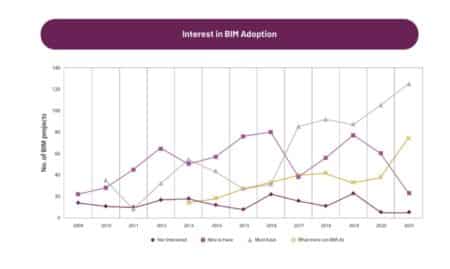THE USE OF BIM FOR COST SAVINGS in construction has become a given for large contractors and firms, while many are still trying to acquire BIM capabilities. Familiarity with BIM processes and the ability to manage BIM-related data and collaboration tools has prepared today’s architects, engineers, and builders for the next level. What appears to be the coming explosion of “BuildTech capabilities as the industry is finally digitized,” says Phillip Bernstein – Architect, Technologist, and Educator at Yale School of Architecture.
For generating high-impact outcomes regarding cost and time savings in construction, BIM services are proving their worth. BIM for contractors means more than streamlining construction workflows. It is also helping to reuse knowledge by transforming CAD-based drawings into 3D model visualization. A report by Smart Market suggests a 50% increase in projects for contractors using BIM over the next two years.
Today, BIM solution providers are also providing MEP BIM modeling, clash detection, quantity takeoffs, scheduling, cost estimation, and other services. Even smaller general contracting firms are achieving exceptional cost efficiencies through 3D BIM Revit models.
In this article, we discuss why contractors are adopting BIM services to save project costs and time.
Adoption of BIM services over the last decade
Although the use of BIM services has increased over the past few years, many stakeholders are still hesitant to adopt BIM for their construction projects. Much of the reluctance stems from fears of disruption in routine operations and inconsistent brand experiences that any system change may create. However, with clients moving to BIM, contractors are hiring expert support to manage the change.
The figure below shows the increase in BIM adoption over the last decade. UK contractors have been at the forefront of adopting BIM, followed by those in other countries where BIM has been made mandatory in construction projects.
“The UK is seen as a world leader in BIM – not just in its implementation of it – but in its approach to purpose-driven information management,” says Adam Matthews – Head of the International Construction Innovation Hub and Chair of the Global BIM Network. “I see BIM becoming a business-as-usual, to a point where we will not call it BIM anymore, but the journey is still long, and we do not need to jump the steps,” says Marzia Bolpagni, Head of BIM International, Associate Director, Mace.
However, since BIM is object-based and reinforced with parametric Revit modeling, changes made to a single object or component are reflected within all the aspects of the 3D model. BIM streams every piece of data into a single source of truth within the 3D model.
A report by Smart Market suggests a 50% increase in projects for contractors using BIM over the next two years.
General contractors and specialty contractors can access endless layers of information through enhanced BIM workflows. With BIM, a project is built at two different levels: the virtual world and the physical world. Because of this advantage, contractors are rushing to find experts to integrate BIM into their workflows. The ease of resolving clashes and finalizing designs at the pre-construction stage is not available through other means.
BIM for cost savings: How contractors stand to gain
Many problems plagued construction projects in the past whenever speed and scale were required, and projects that demanded high accuracy took decades to finish. Manufacturing every building component or object on site led to inaccurate fabrications, erection clashes, and low-quality construction. General contractors and specialty contractors working solely with 2D shop drawings, construction drawings, and other 2D documents have always experienced collaboration issues in the field.
BIM has removed these ambiguities with model-extracted shop and construction drawings. Using accurate and complete shop drawings to manufacture components for prefabrication improves on-site installation. Fabricating components in a controlled environment, moving them to the site, and assembling them in the field is now faster, more accurate, and more efficient for general and specialty contractors.
A study conducted in 2021 found that contractors using BIM gained the five top benefits. A high percentage of successful projects topped the list, followed by improved stakeholder engagement, a greater range of service offerings, higher bid efficiency, and an increased win rate.
55% of BIM users have brought down the time required to communicate, collaborate, make decisions, and build and run workflows.

Business benefits from BIM are reportedly increasing from study data based on success rates, stakeholder engagement, bid efficiency, and more. Moreover, cost control is also reported at high/very high for nearly 50% of general contractors (middle image). Click on the image to zoom to a large view. (Image: Dodge Data & Analytics)
Besides quality gains, contractors have pointed out four critical cost-control benefits of using BIM. The ratings were fairly consistent across the four cost-control parameters.
How do BIM services help contractors save project costs?
Adopting BIM services for a construction project can enable contractors to save costs right from the initial stages of planning. BIM is extremely crucial in the pre-construction phase, as it brings contractors, subcontractors, and every other stakeholder to the same page early in the planning stage. Being in a single room collaborating on a single model with 360 visualizations in a virtual space leads to preemptive conflict detection and resolution. With clashes taken care of, rework and project delays are reduced, leading to savings in project costs and time!
The biggest thing about BIM is that it is moving us back to Interdisciplinary work.
BIM also helps contractors design and visualize inaccessible areas, which is difficult, if not impossible, with a primarily 2D setup. 3D BIM models are visual and data-rich, giving contractors a complete snapshot of the actual space.
In an instance of cost optimization using BIM, a general contracting company from Muscat, Oman, could achieve $7 million in cost savings with 100% installation of MEP systems, reduced change orders, and eliminated field conflicts.
BIM makes problem identification and resolution simple early in the building process – before you even get the mud out of the ground on the field.
A survey by Autodesk suggests that 61% of BIM users can lower project errors and data ambiguities.
“The biggest thing about BIM is that it is moving us back to Interdisciplinary work,” says Kathleen Liston, president of Moderna Homes and author of several acclaimed books on BIM. A contractor can eliminate clashes between electrical wiring and HVAC systems by using simulations to find the best location for streamlined and interference-free installations. Exacting material quantities with accurate BOQs and BOMs reduces material waste and construction costs. Traditionally, contractors have used 2D drawings to calculate takeoffs, leading to erroneous construction outcomes. But BIM has changed all that.
Wrapping it up
BIM has become the most powerful tool for contractors to achieve high-impact building outcomes. In the present day, it isn’t only large contractors and big projects that are leveraging BIM tools; medium-sized contracting firms have begun exploring the capabilities of BIM for multiple projects. BIM not only helps in material cost and planning but also improves communication and collaboration. The verdict is clear that investing in BIM will help contractor companies meet project deadlines, reduce costs, and foster high-quality construction.
About Author
Bhushan Avsatthi is a talented architect with over 22 years in the field. He oversees the BIM division of HitechDigital, managing multiple teams of architects, structural and MEP engineers, LEED consultants, and energy modeling experts. He has spoken at various international BIM conferences and is deeply involved in green initiatives. His thoughts on global best practices in building design have been published in multiple architectural and engineering journals.





Reader Comments
Comments for this story are closed